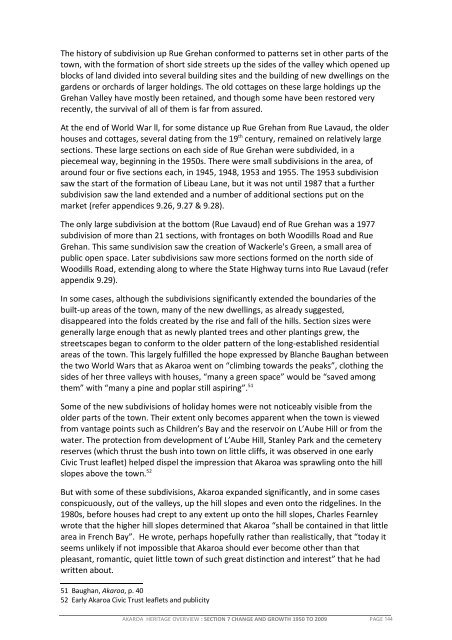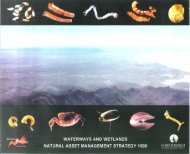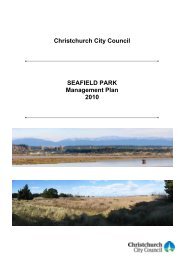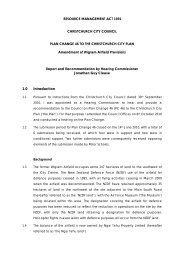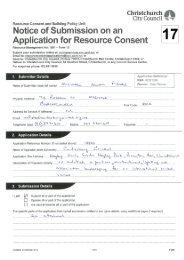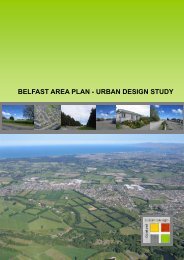Akaroa Historical Overview - Christchurch City Council
Akaroa Historical Overview - Christchurch City Council
Akaroa Historical Overview - Christchurch City Council
You also want an ePaper? Increase the reach of your titles
YUMPU automatically turns print PDFs into web optimized ePapers that Google loves.
The history of subdivision up Rue Grehan conformed to patterns set in other parts of the<br />
town, with the formation of short side streets up the sides of the valley which opened up<br />
blocks of land divided into several building sites and the building of new dwellings on the<br />
gardens or orchards of larger holdings. The old cottages on these large holdings up the<br />
Grehan Valley have mostly been retained, and though some have been restored very<br />
recently, the survival of all of them is far from assured.<br />
At the end of World War ll, for some distance up Rue Grehan from Rue Lavaud, the older<br />
houses and cottages, several dating from the 19 th century, remained on relatively large<br />
sections. These large sections on each side of Rue Grehan were subdivided, in a<br />
piecemeal way, beginning in the 1950s. There were small subdivisions in the area, of<br />
around four or five sections each, in 1945, 1948, 1953 and 1955. The 1953 subdivision<br />
saw the start of the formation of Libeau Lane, but it was not until 1987 that a further<br />
subdivision saw the land extended and a number of additional sections put on the<br />
market (refer appendices 9.26, 9.27 & 9.28).<br />
The only large subdivision at the bottom (Rue Lavaud) end of Rue Grehan was a 1977<br />
subdivision of more than 21 sections, with frontages on both Woodills Road and Rue<br />
Grehan. This same sundivision saw the creation of Wackerle's Green, a small area of<br />
public open space. Later subdivisions saw more sections formed on the north side of<br />
Woodills Road, extending along to where the State Highway turns into Rue Lavaud (refer<br />
appendix 9.29).<br />
In some cases, although the subdivisions significantly extended the boundaries of the<br />
built-up areas of the town, many of the new dwellings, as already suggested,<br />
disappeared into the folds created by the rise and fall of the hills. Section sizes were<br />
generally large enough that as newly planted trees and other plantings grew, the<br />
streetscapes began to conform to the older pattern of the long-established residential<br />
areas of the town. This largely fulfilled the hope expressed by Blanche Baughan between<br />
the two World Wars that as <strong>Akaroa</strong> went on “climbing towards the peaks”, clothing the<br />
sides of her three valleys with houses, “many a green space” would be “saved among<br />
them” with “many a pine and poplar still aspiring”. 51<br />
Some of the new subdivisions of holiday homes were not noticeably visible from the<br />
older parts of the town. Their extent only becomes apparent when the town is viewed<br />
from vantage points such as Children’s Bay and the reservoir on L’Aube Hill or from the<br />
water. The protection from development of L’Aube Hill, Stanley Park and the cemetery<br />
reserves (which thrust the bush into town on little cliffs, it was observed in one early<br />
Civic Trust leaflet) helped dispel the impression that <strong>Akaroa</strong> was sprawling onto the hill<br />
slopes above the town. 52<br />
But with some of these subdivisions, <strong>Akaroa</strong> expanded significantly, and in some cases<br />
conspicuously, out of the valleys, up the hill slopes and even onto the ridgelines. In the<br />
1980s, before houses had crept to any extent up onto the hill slopes, Charles Fearnley<br />
wrote that the higher hill slopes determined that <strong>Akaroa</strong> “shall be contained in that little<br />
area in French Bay”. He wrote, perhaps hopefully rather than realistically, that “today it<br />
seems unlikely if not impossible that <strong>Akaroa</strong> should ever become other than that<br />
pleasant, romantic, quiet little town of such great distinction and interest” that he had<br />
written about.<br />
51 Baughan, <strong>Akaroa</strong>, p. 40<br />
52 Early <strong>Akaroa</strong> Civic Trust leaflets and publicity<br />
AKAROA HERITAGE OVERVIEW : SECTION 7 CHANGE AND GROWTH 1950 TO 2009 PAGE 144


